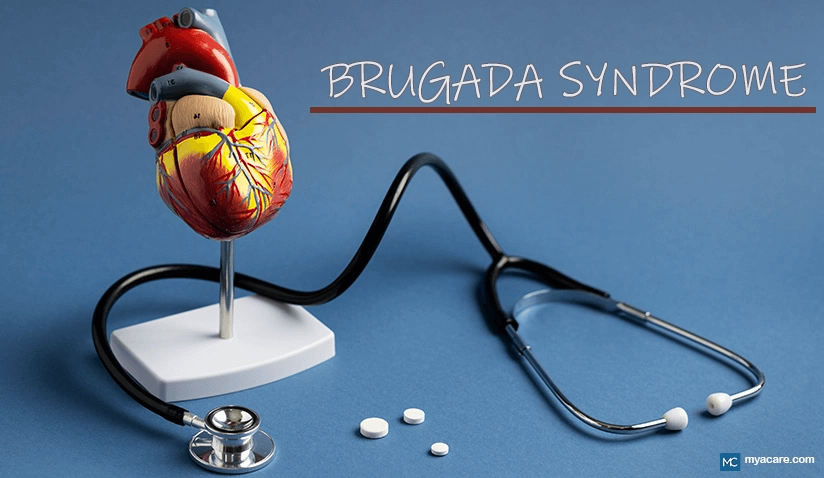Brugada Syndrome: Symptoms, Risk Factors, Complications, Treatment and Latest Research

Medically Reviewed by Dr. Sony Sherpa, (MBBS)
Brugada syndrome (BrS) is a rare but potentially life-threatening genetic heart condition that can lead to abnormal heart rhythms, including the life-threatening arrhythmia known as ventricular fibrillation (v-fib). The syndrome is characterized by abnormal electrical activity in the heart, which can cause fainting (syncope) or even sudden cardiac death (SCD). The presence of Brugada syndrome often goes unnoticed until a person experiences an arrhythmic event, making its diagnosis and management critical. Though Brugada syndrome is rare, understanding its causes, symptoms, diagnosis, treatment, and ongoing research is essential for a better prognosis and quality of life for patients.
In asymptomatic individuals with Brugada syndrome, life expectancy is typically normal as they are considered low-risk and do not experience arrhythmic events. However, the risk of sudden death due to arrhythmias increases in symptomatic individuals, particularly those who experience syncope or have a history of cardiac arrest. With appropriate treatment, particularly the insertion of an Implantable Cardioverter-Defibrillator (ICD), patients can have improved survival rates.
What is Brugada Syndrome?
To understand Brugada syndrome, it is important to be aware of the normal functioning of the heart’s electrical system. The heart's rhythm depends on the coordinated flow of electrical impulses through the heart muscle. These impulses are responsible for triggering the heart's contractions, ensuring it beats regularly and efficiently. The heart's electrical system functions through ion channels, which are specialized proteins that manage the flow of ions (including sodium, potassium, and calcium) across heart cells.
Brugada syndrome is a genetic condition that disrupts the heart's electrical signaling, primarily by affecting ion channels. The most common genetic mutation associated with Brugada syndrome is in the SCN5A gene, which encodes a sodium channel responsible for the heart's electrical impulses. Dysfunction of sodium channels due to mutations in this gene can cause abnormal electrical signals and potentially life-threatening arrhythmias like ventricular tachycardia (VT) and ventricular fibrillation (v-fib).
There are three recognized types of Brugada syndrome based on the pattern of ST-segment elevation seen on an electrocardiogram (ECG):
- Type 1: Coved ST-segment elevation in leads V1-V3.
- Type 2: Saddleback ST-segment elevation in leads V1-V3.
- Type 3: Non-specific pattern with minimal ST elevation.
The Type 1 pattern is the most indicative of Brugada syndrome and is typically associated with the highest risk of arrhythmic events.
Causes of Brugada Syndrome
The primary cause of Brugada syndrome is genetic mutations. Brugada syndrome typically follows an autosomal dominant inheritance pattern, meaning there is a 50% chance of inheriting the condition if one parent carries the defective gene. The most well-known mutation is in the SCN5A gene, which affects the sodium channels involved in conducting electrical signals in the heart. However, mutations in other genes, including CACNA1C, CACNB2, and SCN1B, have also been linked to the condition.
The genetic nature of Brugada syndrome makes it essential for family members of individuals diagnosed with the condition to undergo genetic testing to assess their risk of inheriting the disorder. Genetic testing allows doctors to identify individuals at risk of sudden cardiac events, even if they show no symptoms.
In addition to genetic mutations, certain external triggers can exacerbate or unmask Brugada syndrome, leading to arrhythmic events. One of the most common triggers is fever, particularly in children, which can provoke changes in heart rhythm in individuals with Brugada syndrome. Certain medications, including some antiarrhythmics, antidepressants, and anesthetics, can unmask or worsen Brugada Syndrome in genetically susceptible individuals, sometimes referred to as drug-induced Brugada Syndrome. Electrolyte imbalances (e.g., hypokalemia, hyperkalemia), excessive alcohol consumption, dehydration, and heat exhaustion are other potential triggers.
Risk Factors
Brugada syndrome is more common and severe in males, likely due to the influence of male hormones such as testosterone. It is also more prevalent in individuals of Asian descent, especially those from Southeast Asia, with much lower rates reported in populations of European or African descent. The disorder typically presents in adulthood, with most cases diagnosed between the ages of 30 and 40, though it can affect individuals at any age.
Brugada Syndrome Symptoms
Many individuals with Brugada syndrome remain asymptomatic throughout their lives, only being diagnosed incidentally through family screening or routine ECGs. However, when symptoms do occur, they may include:
- Palpitations: A sensation of irregular or fast heartbeats.
- Dizziness or lightheadedness: Often a result of irregular heart rhythms.
- Syncope (fainting): Fainting episodes, which may occur suddenly, often without warning.
- Sudden cardiac arrest: This can occur most commonly during rest or sleep and is the most severe manifestation of Brugada syndrome.
Symptoms may also occur after eating a heavy meal or during periods of physical exertion, though the latter is less common.
Complications
The most significant risk associated with Brugada syndrome is ventricular fibrillation (v-fib), a rapid, irregular heartbeat (arrhythmia) that can trigger sudden cardiac arrest. Without immediate intervention, such as defibrillation, v-fib can be fatal. Ventricular tachycardia (VT), another arrhythmic complication, can also lead to fainting, and if left untreated, it can degenerate into v-fib, increasing the risk of sudden cardiac death.
Diagnosis
Brugada syndrome is diagnosed based on characteristic ECG findings, particularly ST-segment elevation in the right precordial leads (V1-V3). Healthcare providers may use sodium channel blockers like ajmaline or flecainide to reveal the characteristic ECG changes and confirm the diagnosis.
Genetic testing is also a critical component of diagnosis, as it helps identify mutations in genes such as SCN5A. Electrophysiological studies may be conducted to assess the risk of life-threatening arrhythmias and determine the need for an ICD. Conditions like arrhythmogenic right ventricular cardiomyopathy and long QT syndrome can mimic Brugada syndrome, making differential diagnosis necessary.
Treatment
The treatment of Brugada syndrome depends on the severity of symptoms and the risk of sudden cardiac death. ICD implantation is recommended for individuals who have experienced a cardiac arrest or syncope or those with a high-risk genetic profile. This device monitors the heart’s rhythm continuously. If a dangerous arrhythmia is detected, the ICD can deliver an electric shock to restore the normal heart rhythm.
Catheter ablation is another treatment option, typically used in cases of recurrent arrhythmias that do not respond to other therapies. This procedure involves using a catheter to target and destroy the abnormal tissue in the heart responsible for the arrhythmia.
Pharmacological management may be considered for patients who cannot undergo ICD implantation. Patients with Brugada syndrome should avoid certain medications, including sodium channel blockers and those that prolong the QT interval (time taken by the heart to recharge between beats), as these can worsen their condition.
Lifestyle changes are crucial for managing Brugada syndrome, in addition to medical treatment. These include avoiding alcohol, managing fever with antipyretics, and avoiding strenuous physical activities, especially competitive sports.
Brugada Syndrome: Foods to Avoid
Avoid processed, high-fat foods that worsen heart health, excess salt that raises blood pressure, and stimulants like caffeine and taurine, which disrupt sodium channels and increase arrhythmia risk.
Latest Advances in Brugada Syndrome Research
Ongoing research into Brugada syndrome has focused on improving genetic testing and advancing our understanding of the condition’s genetic basis. Whole-genome and exome sequencing have enabled the identification of additional genetic mutations linked to the disorder. Furthermore, risk prediction models and scoring systems aim to improve the identification of those at high risk for sudden cardiac death.
Research into new pharmacological agents is also ongoing, with studies exploring potential treatments to improve the management of Brugada syndrome and reduce the risk of arrhythmic events.
Prognosis
The prognosis for individuals with Brugada syndrome largely depends on the presence of symptoms and the treatment approach. Asymptomatic individuals with no history of arrhythmic events can generally live normal lives, although regular follow-up and ECG monitoring are necessary. For those with a history of syncope or cardiac arrest, the implantation of an ICD has significantly improved survival rates.
Living with Brugada Syndrome
Living with Brugada syndrome requires careful management and ongoing monitoring. Regular follow-up visits with a healthcare provider, along with routine ECGs, are essential for assessing the heart's electrical activity. Individuals with Brugada syndrome and their families should also consider genetic counseling to understand the risks and available options.
Brugada Syndrome and COVID-19
The COVID-19 pandemic prompted concerns about the virus's potential effects on people with Brugada syndrome. Studies have suggested that COVID-19 infections may exacerbate arrhythmic events in susceptible individuals, though more research is needed to fully understand this relationship.
Brugada Syndrome and Pregnancy
Pregnancy in women with Brugada syndrome presents unique challenges, as hormonal changes during pregnancy may influence the electrical activity of the heart. Careful management and regular monitoring are essential to reduce the risk of arrhythmic events during pregnancy and childbirth.
Brugada Syndrome and Anesthesia
Anesthetic drugs should be carefully selected in patients with Brugada syndrome to avoid exacerbating arrhythmias. Commonly used anesthetics require continuous cardiac monitoring due to rare reports of arrhythmogenic effects. Sodium channel blockers are generally contraindicated due to their potential to increase arrhythmic risk. While local anesthetics like lidocaine can be used cautiously in low doses, close monitoring is essential.
Exercise and Brugada Syndrome
Exercise should be approached with caution, particularly strenuous physical activity. Talk to your doctor about safe exercise levels.
Conclusion
Brugada syndrome is a rare but serious heart condition that requires careful diagnosis and management to prevent life-threatening arrhythmic events. With appropriate treatment, including the use of ICDs, pharmacological management, and lifestyle modifications, individuals with Brugada syndrome can lead fulfilling lives. However, regular monitoring, genetic counseling, and research into new therapies are essential for improving long-term outcomes for those affected by this condition.
To search for the best Cardiology Healthcare Providers in Croatia, Germany, India, Malaysia, Poland, Singapore, Spain, Thailand, Turkey, the UAE, the UK and The USA, please use the Mya Care Search engine
To search for the best Healthcare Providers worldwide, please use the Mya Care search engine.
The Mya Care Editorial Team comprises medical doctors and qualified professionals with a background in healthcare, dedicated to delivering trustworthy, evidence-based health content.
Our team draws on authoritative sources, including systematic reviews published in top-tier medical journals, the latest academic and professional books by renowned experts, and official guidelines from authoritative global health organizations. This rigorous process ensures every article reflects current medical standards and is regularly updated to include the latest healthcare insights.

Dr. Sony Sherpa completed her MBBS at Guangzhou Medical University, China. She is a resident doctor, researcher, and medical writer who believes in the importance of accessible, quality healthcare for everyone. Her work in the healthcare field is focused on improving the well-being of individuals and communities, ensuring they receive the necessary care and support for a healthy and fulfilling life.
Featured Blogs



